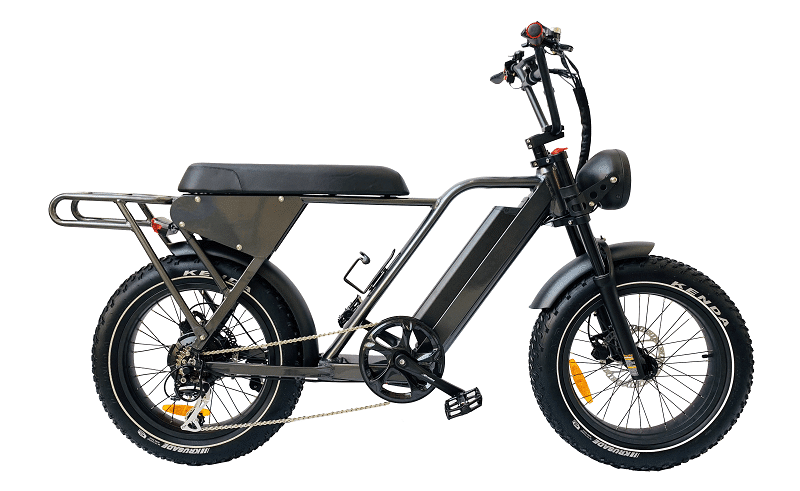Last Updated on August 8, 2022 by Editorial Staff
Electric bikes, also known as e-bikes, have taken the cycling industry by storm over the last five years. What started as the niche side project of a few dedicated manufactures has morphed into a global phenomenon that has gone on to draw the attention of major brands and fundamentally changed the cycling industry. E-bikes have influenced nearly every facet of bicycle design, from frame construction, and hub dimensions, and to braking systems now widely used across regular bikes along with e-bikes.
What is more, e-bikes have opened up cycling to an entirely new segment of consumers who otherwise may never have discovered the thrills this venerable sport can provide. Today, we’re going to take a look at one specific type of e-bike, the electric fat bike. So if you’re in the market for one of these remarkable machines, keep reading to learn about a few of the key considerations to make before heading online or down to your local shop to pick one up.
Choosing the Perfect Electric Fat Bike
Electric fat bikes or electric bikes, like all quality bicycles, are expensive. So, you want to be sure to pick the perfect one before you throw down serious cash. Set out below you’ll find some of the key factors to consider before buying your e-fat bike. Ultimately, the decision will come down to how you want to use the bike and the conditions you’ll be riding it most frequently.
Tire size
“Fat bikes,” in general, are a specialized sub-type of mountain bikes. Fat bikes get their name from the enormous tires they use. While regular mountain bikes typically use tires between 2 and 2.5 inches (5 to 6.4 cm) in diameter, and according to Little Dragon Fat Bike, fat bikes use tires up to 5 inches wide. These tires are designed to provide massive amounts of traction and also to enable the bike to float over loose surfaces such as snow and sand.
Additionally, standard mountain bikes typically use wheels that are either 26 inches, 27.5 inches, or 29 inches in diameter. Likewise, fat bikes (including e-fat bikes) make use of all these wheel standards as well. Although 26″ wheels are largely a thing of the past for standard mountain bikes, fat bikes use this wheel dimension because it allows for the largest amount of tire clearance in the frame. The 26-inch wheel is also commonly used on a fat tire electric bike for this same reason—maximum tire clearance.
So, the first choice to make is what size wheels you want to run. Luckily, many modern e-fat bikes allow riders to swap between multiple wheel sizes, allowing for many different wheels and tire combinations, without changing the bike’s geometry too much. So, if you’re looking to ride your e-fat bike mostly on loose surfaces such as snow or sand, you’ll appreciate the flotation provided by a plush 26×5.0 tire. But if you anticipate using your e-fat bike for commuting or other activities where speed is key, you’ll likely appreciate the lower weight and rolling resistance provided by a 27.5×4.0 or 29×3.0 tire.
Motor type
The next consideration is the type of motor you want the bike to use. All e-bikes, including e-fat bikes, typically use one of two styles of the motor. The first is a motor that’s built into the bike’s frame and directly connected to the crankset. This type of motor is an excellent choice because it places the bulk of the bike’s weight in the middle of the bike and directly beneath the rider. This allows for more precise handling. Additionally, because the motor drives the cranks directly, the pedaling action is very smooth and often feels quite natural.
The second common type of motor is a motor that’s built into the hub of the rear wheel. These motors are a good choice if you’re looking to keep your costs low, as they’re often less expensive than e-fat bikes with frame-based motors. Additionally, because the motor is built into the rear wheel, riders could swap out the motorized wheel for a standard wheel, drop most of the extra weight, and ride their e-fat bike just like a regular fat bike.
This, of course, alludes to the major drawback of wheel-based motors: the location of the extra weight. Being built into the rear wheel, this type of motor adds substantial extra weight to the rear of the bike. This extra weight on the back of the bike can feel like a sort of “anchor” when riding the bike uphill. It can also negatively affect the bike’s handling. Still, with practice, many riders grow to enjoy fat bikes with wheel-based electric motors. So, you may decide it’s worth it to save a few bucks.
Suspension
Next, you should decide whether you want an e-fat bike with suspension. Most e-fat bikes are “rigid” bikes, which means that neither the front nor the rear wheel uses a shock to allow the wheel to move up and down independently of the frame. But at least a couple of manufacturers make this type of bikes with either a suspension fork or both a suspension fork and a rear shock.
Although an e-fat bike’s massive tires provide a very plush ride in their own right, adding suspension further improves both traction and ride quality by helping the bike conform to whatever surface you’re riding over. The drawback is that e-fat bikes with suspension weigh even more than rigid bikes. The motor, of course, will help the rider push the extra weight, but pushing more weight still requires more energy.
This brings us to our next point.
Range
One of the most important decisions you’ll need to make before buying an e-fat bike is how far you need the bike to be able to go between charges. If you plan to use it just for your daily commuting to work or around town, you can likely get away with a smaller (and therefore lighter) battery. After all, if you can charge your bike every night, you don’t need to worry as much about it running out of battery. But, if you plan to use your bike for epic adventures or multi-day excursions, you’ll want to make sure you get a bike with the biggest battery possible. This will ensure the bike has enough range to get you wherever you need to go on a single charge.

Where to buy an e-fat bike
The final consideration has less to do with the bike itself than it does with servicing the bike in the future. You can easily buy an e-fat bike from any of a variety of online retailers. But the bike with almost certainly requires at least some assembly before you can ride it safely. It will also require regular upkeep.
All bicycles require regular maintenance to function at their best. But the fact that e-fat bikes use motors and sophisticated electronics adds another layer of complexity to the machine. For this reason, buying your e-fat bike from your local bike shop could prove quite valuable, as many bike shops offer special maintenance packages for bikes that are purchased through them.
This is not to say, of course, that your local shop will not service an e-fat bike that you bought online. But they will almost certainly charge you full price to do it. On the other hand, if you’re comfortable wrenching on your equipment, or you just like to figure problems out for yourself, you can often find deals online that brick and motorbike shops simply can’t beat.
Final Thoughts
Electric fat bikes are exhilarating machines that can take you places that regular bikes just can’t. It’s important to remember, of course, to always observe local trail rules (as some trail systems don’t allow e-bikes of any kind). But there’s hardly a better machine for commuting in all seasons and weather conditions. An e-fat bike’s massive tires provide endless traction and a supple ride, while the bike’s motor makes it easier to pedal, meaning you can get wherever you need to go faster and with less effort. Finding the perfect bike takes some time and lots of careful thought, but the factors we set out for you above should go a long way in helping to make your decision an easier one.
